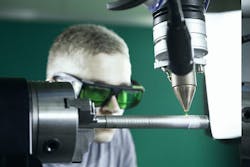Additive manufacturing can be a powerful weapon in producing durable outer protection for sensors used in high-pressure environments, such as pipelines in the gas and oil industry. These coatings significantly improve sensor useful life despite sheer stresses and pressures on the magnitudes of hundreds of bars.
One company that takes the additive-manufacturing route is O.R. Lasertechnologie. To create such coatings, the company’s R&D team invented a powder nozzle that deposits Stellite, a cobalt-chromium-based alloy, onto the sensors. Using a compact EVO mobile laser welding system, they deposit Stellite powder coaxially with the laser beam at deposition rates as high as 5000 mm3/h.
Stellite is traditionally difficult to machine onto sensor surfaces—the intense heat during layer deposition causes the sensor material and the Stellite to melt together, impacting the integrity of the sensor. But by applying a powder-based laser cladding method called direct metal deposition (DMD), the team melted Stellite onto the sensor with a low-power laser as low as 200 W. In addition to the low laser temperatures, the coating was melted to the sensors at only a few scattered points to minimize melting of the sensor material.
The Stellite-powder grain sizes are between 45 and 90 µm for undistorted, crack-free coating, and track widths between 200 µm and 2 mm for precise deposition. DMD was also done in a chamber of the noble gas argon, to prevent the coating’s reaction with the atmosphere during deposition and the generation of gas bubbles.
O.R. Laser's powder nozzle can also be controlled with ORLAS SUITE—its new CAM software that enables automatic coating of complex workpieces.To learn about O.R. Laser's technologies and services, visit their website.
About the Author
Leah Scully
Associate Content Producer
Leah Scully is a graduate of The College of New Jersey. She has a BS degree in Biomedical Engineering with a mechanical specialization. Leah is responsible for Machine Design’s news items that cover industry trends, research, and applied science and engineering, along with product galleries. Visit her on Facebook, or view her profile on LinkedIn.
